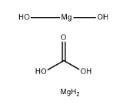Active Pharmaceutical Ingredients (API), popularly speaking, are the raw materials of medicines, only pharmaceutical raw materials are processed into pharmaceutical preparations , can they become medicines available for clinical use, so drugs we usually eat are the finished drugs through processing. Active Pharmaceutical Ingredients based on its sources can be divided into two major categories ,including chemical synthetic drugs and natural chemical drugs. Chemical synthetic drugs can be divided into organic synthetic drugs and inorganic synthetic drugs. Inorganic synthetic drugs are inorganic compounds ( very few is element), such as aluminum hydroxide, magnesium trisilicate which are used for the treatment of gastric and duodenal ulcers ; organic synthetic drugs are mainly composed of drugs made by basic organic chemical raw materials, through a series of organic chemical reactions (such as aspirin, chloramphenicol, caffeine, etc.). Natural chemical drugs ,based on its sources,can be divided into two categories including biochemical drugs and plant chemical drugs. Antibiotics are generally made by the microbial fermentation, which belongs to the biochemistry category. A variety of semi-synthetic antibiotics occurs in recent years,which are biosynthesis and chemical synthesis combining products.Among active Pharmaceutical Ingredients, the organic synthetic drugs varieties, yields and values have the largest proportion,which are the main pillars of the chemical and pharmaceutical industries. The quality of active Pharmaceutical Ingredients decides whether the formulation is good or bad , so its quality standards are very strict ,countries in the world have developed national pharmacopoeia standards and strict quality control methods for its widely used active Pharmaceutical ingredients.
Tildacerfont:Mechanism, Bioactivity and Chemical and Toxicological Studies
The tildacerfont belongs to thiazolyl-pyrazolopyrimidine compound. It is a corticotropin-releasing factor type-1 receptor antagonist, may reduce excess androgen production, allowing for glucocorticoid
Jan 12,2023 APIExemestane used to treat breast cancer
Exemestane is an oral steroidal aromatase inhibitor used to treat hormone responsive breast cancers in women who are postmenopausal - have gone through menopause.
Jan 11,2023 APIThe introduction of Ketone Ester
The Ketone Ester, with the CAS No: 1208313-97-6, is also known as (3R)-3-Hydroxybutanoic acid (3R)-3-hydroxybutyl ester. This chemical’s molecular formula is C8H16O4 and molecular weight is 176.21.
Jan 11,2023 APIThe application of Lurasidone hydrochloride
The lurasidone hydrochloride, with the CAS No: 367514-88-3, is also known as Lurasidonhydrochloride. This chemical’s molecular formula is C28H36N4O2S and molecular weight is 492.684. It is an atypical
Jan 10,2023 APIThe introduction of licochalcone C
The licochalcone C, with the CAS No: 144506-14-9, is also known as 4,4'-Dihydroxy-2-Methoxy-3-prenylchalcone. This chemical’s molecular formula is C21H22O4 and molecular weight is 338.4. Licochalone C
Jan 9,2023 APIMethenolone Acetate Side Effects
Methenolone acetate is an oral anabolic steroid. It is favored by athletes during the fat loss phase of training, when lean tissue growth and toned muscle rather than raw volume are the key goals.
Jan 6,2023 APIMagnesium carbonate hydroxide: Application and Chemical Studies
Magnesium carbonate hydroxide exists as dilute loose powder or crisp monoclinic crystals. It is white , non-toxic, odorless, and stable in air.
Jan 6,2023 APIThymalfasin: Bioactivity And Mechanism of Action Studies
The Thymalfasin is a 28-amino acid peptide, the N-terminus of a larger peptide, prothymosin, with no tertiary structure and no other post-translational modifications except an N-terminal acetylation.
Jan 5,2023 APINitazoxanide uses and side effects
Nitazoxanide is a broad-spectrum antibacterial drug that has been used for the treatment of infectious diarrhoea since 1966. It works by stopping the reproduction of certain substances that the parasi
Jan 5,2023 APIGSK-J4 HCl: Mechanism And Bioactivity studies
GSK-J4 is a potent dual inhibitor of H3K27me3/me2-demethylases?JMJD3/KDM6B?and?UTX/KDM6A?with?IC50s of 8.6 and 6.6 μM, respectively.
Jan 5,2023 API












